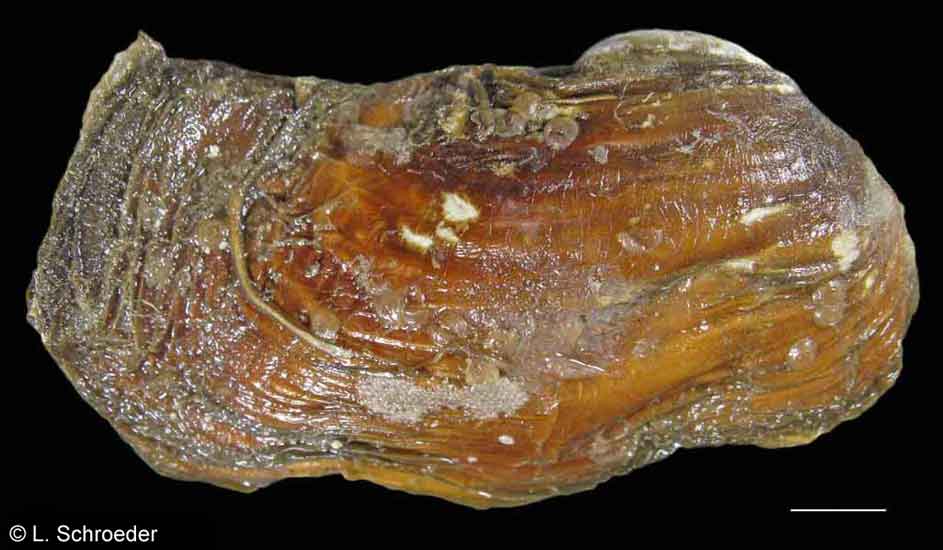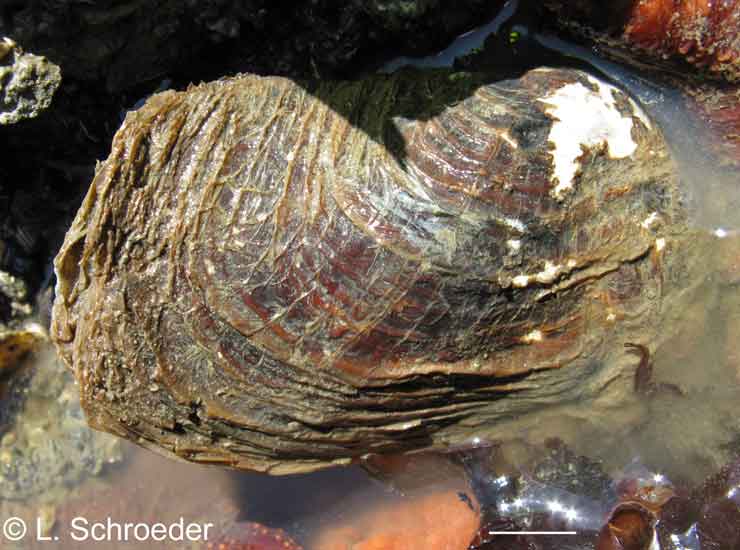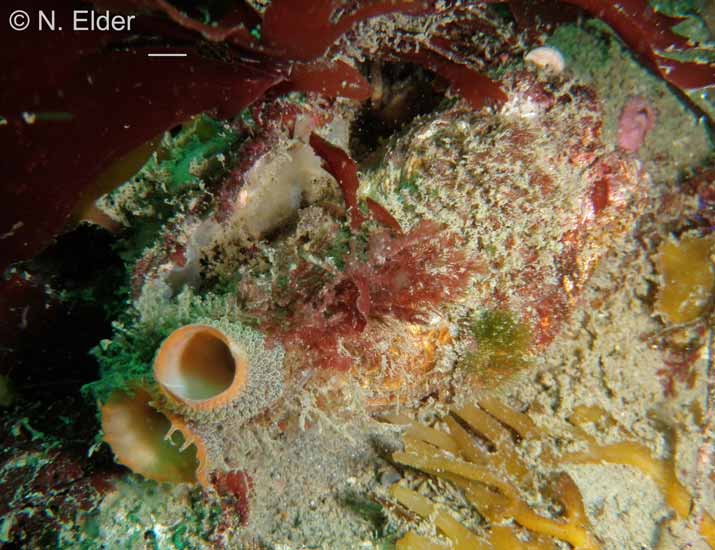Click on photo to enlarge. Scale line in photo equals 1cm unless otherwise specified.
* Species which are commonly encountered on the beach.
Pandoridae

San Juan Islands, WA
south end Queen Charlotte
Sound, BC
Pandora filosa Carpenter, 1864Western Pandora
subtidal, 20-300m northern Mexico to central Alaska size to 27mm
This shell has an elongated tip. As with all Pandora, one valve is flat, while the other is inflated. Small specimens may have sand particles on the periostracum.
(synonyms - Pandora gouldii, Lyonsia haroldi, Lyonsia nesiotes)


San Juan Islands, WA
San Juan Islands, WA
Pandora wardiana A.Adams, 1860Giant Pandora
subtidal, 5-400m size to 76mm
Oregon to northern Alaska; Japan to Siberia
This is the largest species of Pandora. The posterior end is prominently rounded, separated by a distinct furrow from the anterior end.
(synonyms - Pandora grandis, Pandora forresterensis)
Lyonsiidae
Petersburg, AK
Anacortes, WA, intertidal
Port Angeles,WA, subtidal
Entodesma navicula (A.Adams & Reeve, 1850)Northwest Ugly Clam *
intertidal
to 60m northern Mexico to northern
Alaska; Japan size to 150mm
This
is commonly found intertidally. It lives nestled in rocks and
therefore its shape can be somewhat variable. The shell grows
distorted and has a thick, periostracum which has folds in it.
The interior is nacreous. The shell is usually covered with
grit and encrustations and can easily go unnoticed between the rocks.
(synonym - Entodesma saxicola)
 Esperanza Inlet, Vancouver Island, BCPandora punctata Conrad, 1837Punctate Pandorasubtidal to 50m size to 45mmnorthern Mexico to Esperanza Inlet,
Esperanza Inlet, Vancouver Island, BCPandora punctata Conrad, 1837Punctate Pandorasubtidal to 50m size to 45mmnorthern Mexico to Esperanza Inlet,
Vancouver Island, BCThis shell has a strongly curved shape.
Verticordiidae

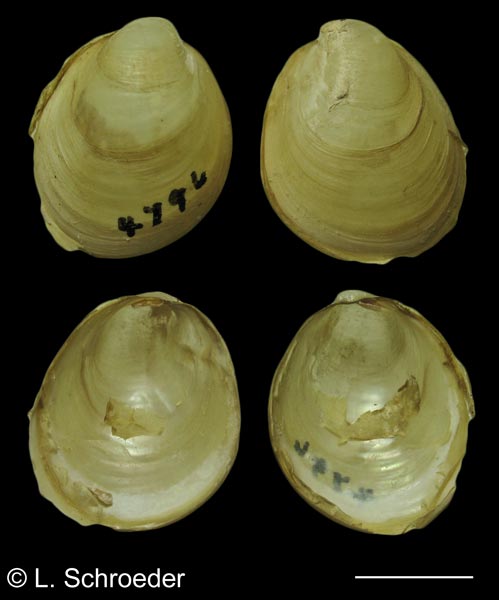

Haida Gwaii, BC
Hope Island, BC Whidbey Island, WA, subtidal
Mytilimeria nuttallii Conrad, 1837
Bladderclam
intertidal to 70m size to 47mm
northern Mexico to southern Alaska
This
is rarely found intertidally. The shell is very fragile. It is
usually covered with tunicates so hard to see and dead shells break
apart very quickly. It can be somewhat variable in shape.
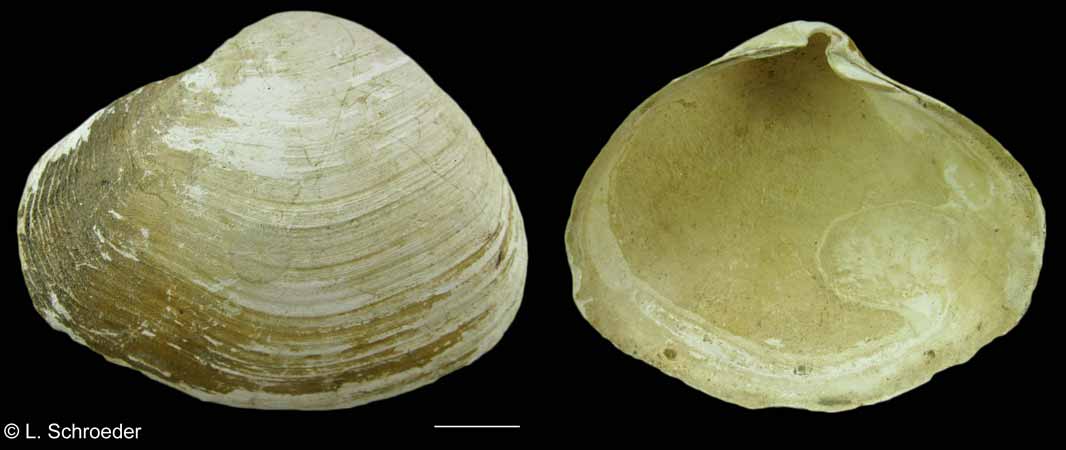
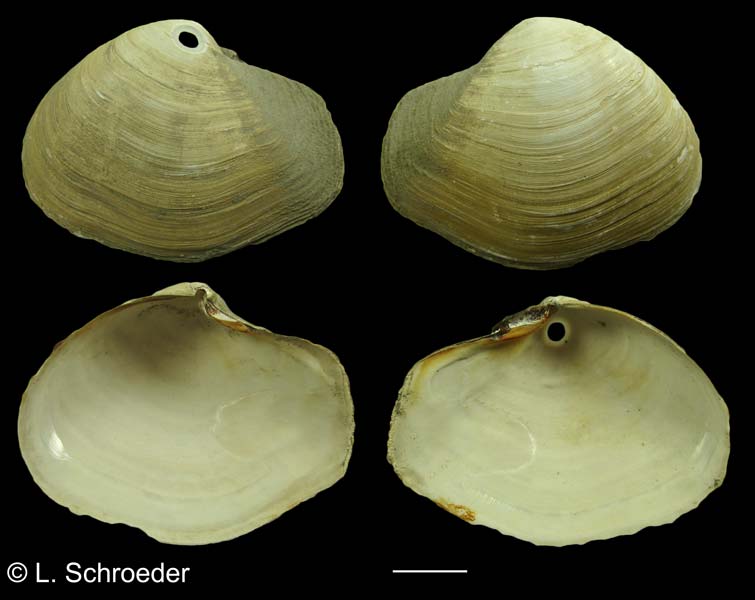
Victoria, BC
Barkley Sound, BC
Thracia trapezoides Conrad, 1849Trapezoidal Thraciid
subtidal, 11-200m northern Mexico to southern Alaska size to 65mm
This
shell is rarely seen. It is generally more angular in appearance than
the other Thracia species. As with the others, it lives in
sand and mud. The right valve is slightly larger than the left.
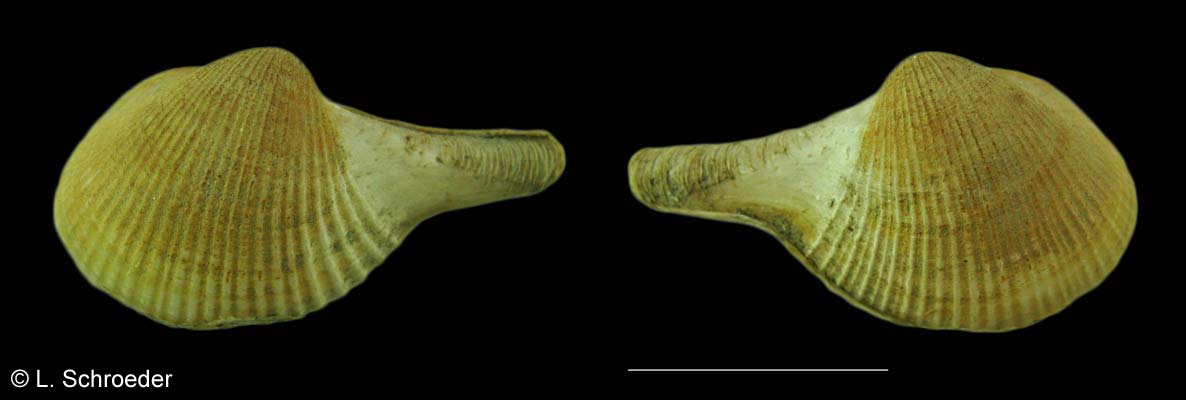 Barkley Sound, BC
Barkley Sound, BC
Cardiomya planetica (Dall, 1908)Fine-Ribbed Cardiomya
subtidal, 25-3000m Panama to northern Alaska; Galapagos; Japan size to 30mm
This species has numerous, small ribs with a long, narrow rostrum. It lives in mud.
(previous name - Cuspidaria planetica)
Cuspidariidae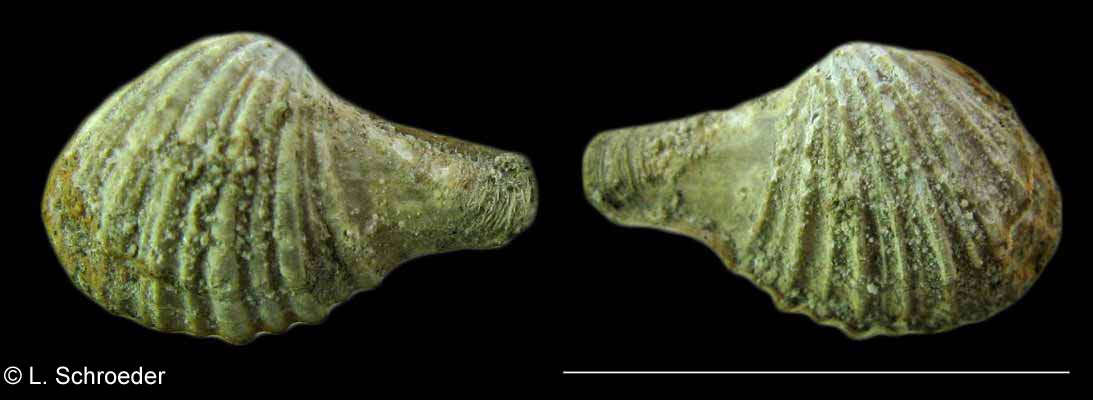 Burrard Inlet, BC
Burrard Inlet, BC
Cardiomya pectinata (Carpenter, 1864)Ribbed Dipper
subtidal, 5-1000m Ecuador to central Alaska; Galapagos size to 40mm
This
species has prominent radial ribs. The elongated rostrum may be
either straight or slightly curved. It lives in sand and mud and
grows larger in its northern range than in does in the south.
(synonyms - Cardiomya oldroydi, Cuspidaria californica)
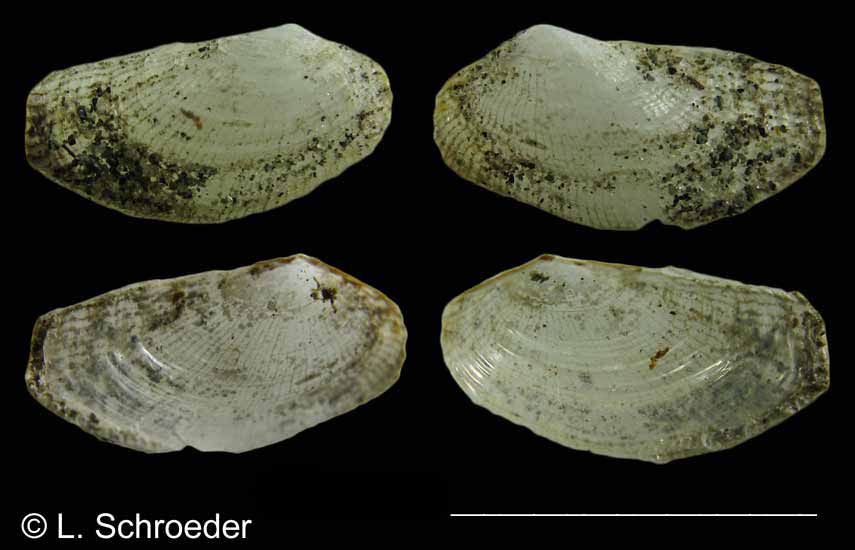
 Southern Gulf Island, BC, subtidal
San Juan
Islands, WA, subtidal
Southern Gulf Island, BC, subtidal
San Juan
Islands, WA, subtidal
Lyonsia californica Conrad, 1837
California Lyonsia
intertidal to 100m size to 42mm
south Mexico to central Alaska
This
fragile shell is very rare to find intertidally. There are fine radial lines on the
periostracum. Sand tends to adhere to the periostracum,
especially in younger specimens.
(synonyms - Lyonsia gouldii, Lyonsia haroldi, Lyonsia nesiotes)
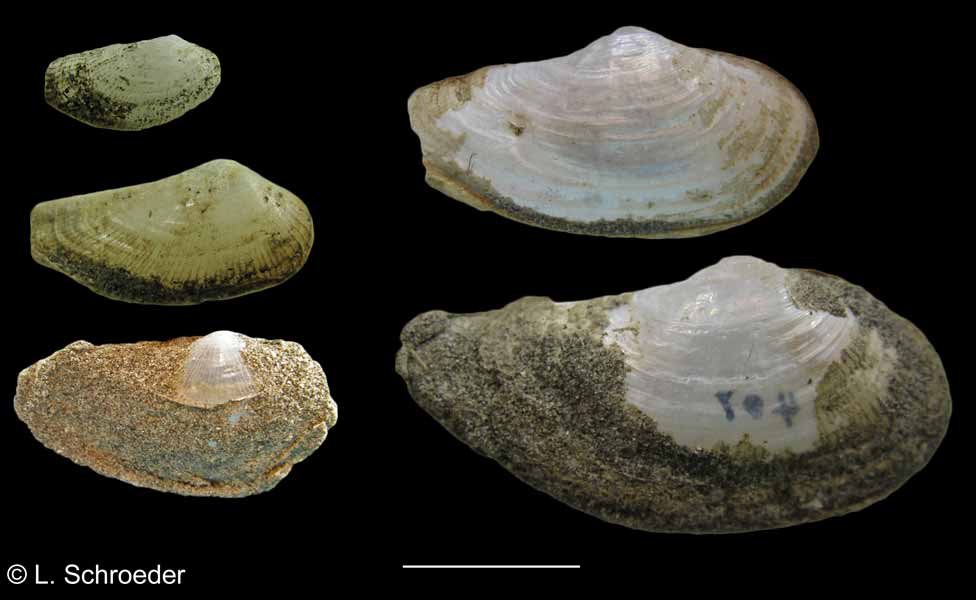 slightly variable and often with sand adhered to it
slightly variable and often with sand adhered to it
Thraciidae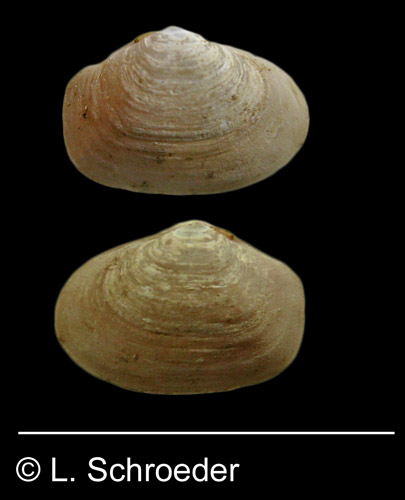 Seymour Inlet, BCThracia challisiana Dall, 1915Pustulose Thraciiidsubtidal, 30-230m size to 60mm
Seymour Inlet, BCThracia challisiana Dall, 1915Pustulose Thraciiidsubtidal, 30-230m size to 60mm
north Mexico to south Alaska
This rare shell has a coarsely granular surface and the right valve is slightly larger than the left.
 central Queen Charlotte Sound, BCThracia myopsis Möller, 1842Arctic Thraciidsubtidal, 50-250m size to 40mm
central Queen Charlotte Sound, BCThracia myopsis Möller, 1842Arctic Thraciidsubtidal, 50-250m size to 40mm
Panarctic and circumboreal, reaching south to central California, the Sea of Japan, Massachusetts and Norway
In this rare shell the right valve is more inflated than the left. It also has a granular surface.
Bivalves
Family Pandoridae, Lyonsiidae,
Verticordiidae, Thraciidae & Cuspidariidae
This page last revised: 5-25-2019




